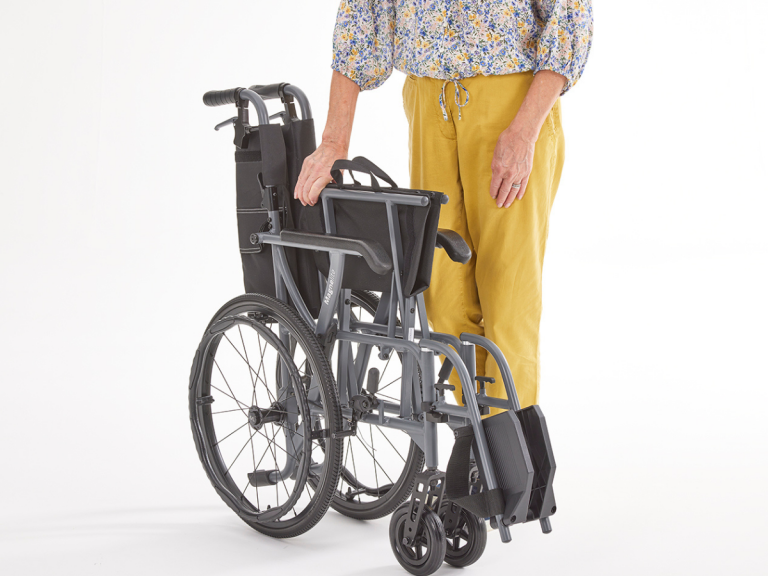5 Common Wheelchair Faults and How to Fix Them
For people with mobility issues or disabilities, wheelchairs can be one of the most important and liberating day-to-day tools available, but problems will inevitably occur. Whether mechanisms of the wheelchair have malfunctioned, or you’re having trouble with the comfort of the chair itself, common wheelchair faults can make them much more frustrating to use than they ever should be.
In this article, Ideas In Action take a look at five common wheelchair faults, as well as what can be done to fix them, to help make sure that your wheelchair remains as comfortable, safe and reliable as possible.
If you need help with your Wheelchair, we provide wheelchair servicing and repairs – contact us for more information, or give our team a call on 0121 371 0780.

1. Worn out, damaged or ill-fitting upholstery
An ongoing, nagging problem that can quickly make using a wheelchair highly unpleasant.
Some wheelchair users require extra padding or cushioning material so as to provide a greater level of support and comfort for their specific needs. If the upholstery on your wheelchair has suffered damage or has become severely worn, this vital support won’t be applied as effectively as it needs to be.
You can get this fixed easily by talking to a professional wheelchair servicing provider, who can help you find the correct solution for you. Whether it’s recommending more suitable cushioning or padding, or working to repair the upholstery of your wheelchair, this problem should be rectified quickly so it doesn’t become a serious, long-lasting issue.
2. Unlocked/locked freewheel lever
The freewheel levers on the backside of your powered wheelchair are a useful tool, but some wheelchair users may not be aware of how they operate. Freewheel levers allow you to swap operation of your wheelchair from motorised to manual, and vice versa, and comes in handy if the battery has drained or if you would rather use your wheelchair manually.
You might find that your motor has become unresponsive, and while this might seem like a serious malfunction, it’s possible that your freewheel levers have been moved to the unlocked position. This disconnects the motor, meaning you can only move the wheelchair manually.
Check to see if the levers have been moved to the wrong position, and put them back to locked to reinstate the motorised function.
3. Battery issues
Powered wheelchairs rely on battery power to function, and while this is typically reliable, battery problems are not uncommon.
It might be as simple as requiring a charge, or the battery may no longer hold a charge at all, and is in need of replacing. Normally, batteries will simply deteriorate over time, and reduced performance won’t be noticeable for at least a year, or longer, depending on your usage patterns. Once your battery starts interfering with how you use your wheelchair day-to-day, it’s time to think about replacing it.
If your battery has worn out unreasonably fast, there could be an internal problem which will need to be inspected by a professional. The best course of action here will likely be to replace it, and it’s worth asking for expert advice right away if you think your battery is starting to fail or has developed a fault.
4. Replacement parts
The longer you use your wheelchair, the more likely you’ll have to replace damaged or worn out parts. Wheels, caster forks and the joystick controller are all aspects of your wheelchair that can suffer damage or accelerated wear.
If you’re finding it harder to maintain control of your wheelchair, it could very well be due to damage sustained from a bump or collision. For instance, your caster forks can become loose, or your wheel may have bent slightly, and will need to be replaced or repaired. Less responsive control is not only frustrating, but also dangerous. As with a car, a broken wheelchair part which takes away control from the user will put you at risk the longer you use it.
Healthy brakes are especially vital, and should be inspected and repaired or replaced as necessary as soon as you notice any damage or signs of failure. When it comes to finding replacement parts, make sure to use a trusted supplier that can help you find the correct parts for your particular make and model of wheelchair.
5. Electrical faults
Powered wheelchairs can commonly be plagued by electrical issues. Connections can come loose, responsiveness can be unpredictable, and your wheelchair may fail to function properly at all. If your battery is fully charged and the freewheel levers are in the locked position, but you’re still having trouble getting your wheelchair to move, there could very well be an internal electrical fault.
The joystick may have lost connection to the motor, and no longer has any effect when you try to move it. Electrical faults can represent longer term issues, or might just be a one-off occurrence caused by a hard shock or bump.
For electrical faults, it’s recommended to get in touch with a professional wheelchair servicing department. They will be able to talk you through simple checks step-by-step, or will come out to you to perform a technical inspection of your wheelchair electrics.
Even the smallest electrical fault is worth chasing up. It could be a temporary, isolated issue, but faulty electrics can pose a major health hazard, so it’s always best to be cautious and not put yourself at unnecessary risk.
Ideas in Action are a family-run company that supply a range of powered wheelchairs, mobility scooters, stairlifts and more to customers in Birmingham and the surrounding West Midlands areas. We’re passionate about helping the more vulnerable members of our community. We always provide friendly customer support and advice, plus warranty and insurance on all our products.
Come see our range of products at our showroom! Get in touch today on 0121 371 0780 or via our contact form.
